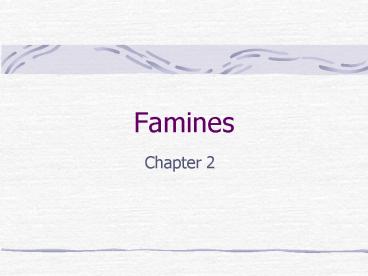Famines - PowerPoint PPT Presentation
1 / 29
Title:
Famines
Description:
Clinical Assessment Physical signs on the body that are symptomatic of nutritional disorders. ... 1. High IMR or low birth-weights imply undernutrition in a region ... – PowerPoint PPT presentation
Number of Views:1591
Avg rating:3.0/5.0
Title: Famines
1
Famines
- Chapter 2
2
Famines
- Are localized, temporary and severe food
shortages.
3
The Irish Potato Famine
- 72 of Irish people illiterate
- Income was 60 of level in Britain
- Two-thirds depend on agriculture for livelihood
- 40 were landless laborers
- 1/3 of Irish depended on potato for food
- Farmers eat 12 lbs of potatoes daily
4
Potato Famine
- The potato blight
- Half of crop destroyed in 1845
- Famine related deaths range from 290,000 to
1,250,000 of a total of 8 million people. - How do you respond to something like this?
- Policy Technology Policy, Trade Policy and
Poverty Alleviation Policy.
5
Famines
- Natural Famines
- Created by government policy
- The Ukraine Famine 1932-1933
- Chinese Great Leap Forward Famine of 1959-1961
- Recent Famines
- North Korea
- Southern Africa
6
When Food Aid is Not Needed
- Box 2.3 Page 22
- Some natural disasters dont interrupt crop and
livestock production and consequently food aid
might do more harm than good.
7
Malnutrition Defined
- Chapter 3
8
I. Four Types of Malnutrition
- Overnutrition
- Secondary Malnutrition
- Micronutrient Malnutrition
- Protein-calorie Malnutrition
9
Overnutrition
- When a person consumes too many calories, this is
the resulting condition.
10
Secondary Malnutrition
- When a person has a condition or illness that
prevents proper digestion or absorption of food.
11
Micronutrient Malnutrition
- A diet lacking sufficient amounts of one or more
essential micronutrients, such as a vitamin or
mineral. (pages 26 27)
12
Protein Calorie Malnutrition
- The under consumption of calories and protein.
13
II. Types of edible seeds
- A. Most of the calories consumed in the world
come from edible seeds either directly or
indirectly - B. 2 kinds
- 1. Cereals
- 2. Pulses
14
II. How much of a nutrient is enough?
- A. A normal distribution (p.38) represents a
group of people based on how much of a specific
nutrient each needs - 1. The mean is the average requirement
15
Increasing intake of a given nutrient
Proportion of individuals
16
- 2. The standard deviation (SD) shows how much
variation there is from the mean - 3. The RDA (recommended daily allowance) for a
nutrient is set at 2 standard deviations above
the mean - a. This will cover the requirements of 97.5 of
the people in this group
17
Measuring Undernutrition
- Chapter 4
18
I. Methods of Direct Assessment of Nutritional
Status
- Clinical Assessment Physical signs on the body
that are symptomatic of nutritional disorders. - Biochemical Assessment - comes from an
examination of body fluids
19
- Dietary Assessment from recall or record
- Anthropometric Assessment science of measuring
the human body and its parts
20
II. Impact of Undernutrition on Physical Growth
and Development
- Low Height for Age or Stunting
- Low Weight for Height or Wasting
- Low Weight for Age or Underweight
- Fat composition of the Body
- Nature vrs Nurture
21
III. Anthropometric Assessment
- A. Reference groups - Provide a standard against
which an individuals nutritional status can be
judged - 1. A person has a nutritional problem if they
are below a certain cut-off point
22
- 2. Cut-off points are based on the median
- a. Median means half are above and half are
below
23
- 3. Percentile
- a. Measures the percentage of the reference
group that is below this point - b. Height at 30th percentile means that 30 of
the group is shorter than this individual - c. Median is the 50th percentile
24
IV. Measuring nutritional status in the aggregate
- A. Draw inferences from a sample using statistics
- 1. Use info from a subset of the population to
infer characteristics of the whole population
25
- B. Use aggregate data on the effects of
undernutrition to infer how much undernutrition
exists - 1. High IMR or low birth-weights imply
undernutrition in a region - 2. High morbidity (illness) rates imply the
existence of undernutrition
26
- C. Look at food availability to infer the
existence of undernutrition - 1. Food balance sheets estimate human
consumption (Table 4.3-p.58) - a. Add up the supply of a specific food
beginning stocks production imports
27
- b. Subtract off the amount used for exports
livestock feed seed ending stocks - c. Whats left can be assumed to go for human
consumption
28
- 2. Convert this to calories, and do for all
foods, to calculate available calories per capita
per day (a widely used measure of malnutrition)
(Table 4.3-p.58)
29
- 3. This is an average and could mean that some
people are consuming above the average and some
people are undernourished - a. Studies of individuals need to be done to
infer the percentage of the population that has
inadequate food intake






























![Download Book [PDF] Silent Violence: Food, Famine, and Peasantry in Northern Nigeria (Geographies PDF PowerPoint PPT Presentation](https://s3.amazonaws.com/images.powershow.com/10119774.th0.jpg?_=20240904062)
